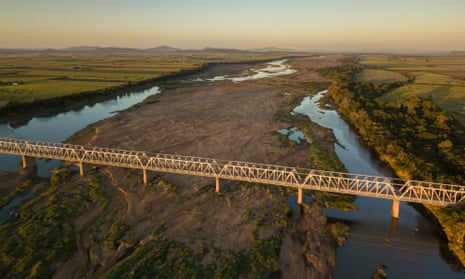The federal government’s announcement of $5.4bn to build the Hells Gates Dam in north Queensland commits money to a project with no final business case, no environmental approvals, and which experts say could further threaten the long-term health of the Great Barrier Reef.
The prime minister, Scott Morrison, announced on Wednesday that his government would build the 2,100 gigalitre dam – about four times the size of Sydney Harbour – that could potentially support 60,000ha of new land for irrigated agriculture.
“We need to build more dams in Australia. Building dams makes our economy stronger by supporting our agricultural industries to realise their true potential,” Morrison said.
A final business case is not expected to be completed until after the federal election. The government has said the funding is guaranteed, subject to the business case.
Earlier feasibility studies have prompted serious questions about the project’s stated economic benefit.
Hells Gates also has no environmental impact statement, and no environmental approvals – a process that could take several years on such a large and complex project.
Some locals leaders, including the Burdekin mayor, Lyn McLaughlin, have expressed concern that dam proposals in the Burdekin River catchment – including the Urannah Dam that also has federal support – have been pushed without studies about their long-term impact on the river system.
Jami Webster, a water quality expert from the Australian Marine Conservation Society, said the announcement was “electioneering”.
Webster said the notion that irrigated agriculture could be expanded in the Burdekin Basin was a “big problem” for the Great Barrier Reef, which is currently enduring a mass coral bleaching event.
Last year, UN science advisors recommended the committee place the reef on a list of world heritage sites “in danger” because of the impacts of bleaching and a lack of progress in improving pollution levels.
But fierce lobbying by the Australian government saw the 21-country committee ignore the recommendation.
“If they were to build Hells Gates there would be a huge expansion of agriculture, which would likely result in a lot more sediment and nutrient pollution to the reef,” Webster said.
Significant work has been done in the Burdekin Basin to assist farmers reduce pollution heading out to the reef from the catchment. They include best-practice management programs for farmers and regulations imposed by the Queensland government. A significant amount of federal funding for the reef, distributed by the Great Barrier Reef Foundation, goes towards programs to reduce sediment and nutrient run-off.
“[Expansion of agriculture] is a big problem,” Webster said.
“That is going to very quickly reverse a lot of the progress made by farmers and industry to date. We’re still a long way to meeting our water quality targets and [Hells Gate] is only going to further hamper that progress.”
Webster said planning for the dam showed it would divert water from downstream areas in the Burdekin Basin, which would in turn increase the build-up of sediment.
The North Queensland Conservation Council said it had obtained full technical reports from a 2018 feasibility study into Hells Gates Dam.
“Detailed reading strongly suggests that the dam is not economically feasible and would become an ongoing burden to taxpayers, with a negative or marginal projected return on investment on public funds,” the council’s analysis of the document said.
It said the return on investment was negative for all but two of the crops investigated – capsicum and avocado.
The organisation promoting the dam, Townsville Enterprise, says on its website that a detailed business case is due to be finalised in April.
Morrison, in his press release on Wednesday, said the business case would not be ready until June.
Independent MP for Kennedy, Bob Katter, has long called for the construction of the dam. But he said he opposed the prime minister’s plan, claiming the dam would be too small to irrigate a large enough area in inland Queensland. Katter was also critical that it would be built on “unreliable basalt rock country”, and claimed locals would oppose it.
“The prime minister thinks he’s pushing a proposal that develops north Queensland when actually it destroys the future and potential of the region,” he said.
Asked in a press conference about Katter’s concerns, Morrison said he had worked “constructively” with the veteran MP, but stood by his plan.
“I love Bob, but it’s not about Bob. And Bob would agree it’s not about Bob,” Morrison said.
Townsville Enterprise says its initial study into Hells Gates showed it “has the potential to redefine northern Queensland’s agriculture sector and underpin long-term export market growth and investment”.
Morrison said the project would create 7,000 jobs during construction and 3,000 new jobs in agriculture.
“Water is a precious resource and we need more dams to better use that resource,” Morrison said.
“We’ve done the homework on Hells Gates Dam and it’s now time to get on and build it. We have put our money on the table, so let’s cut the green tape, get the approvals and get it done.
“This dam will help turn the Burdekin region into an agricultural powerhouse, helping our farmers to stock supermarkets and feed Australia while also securing north Queensland’s water supply and security.”
